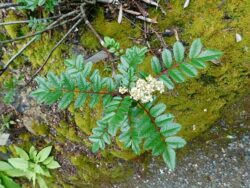In this article, we will be discussing how to grow the only shrub of the Sorbus family in containers. It may seem a bit strange to talk about Sorbus as a shrub, as we generally think about them as popular trees, where many varieties of Mountain Ash, Rowan and Whitebeams are grown. As in any genus, there is one odd man out and that is Sorbus reducta. It is a diminutive shrub that is great as part of a container display in your garden.

Sorbus reducta is a species of flowering shrub that belongs to the Rosaceae (Rose) family. It is native to Western China, especially West Sichuan and North West Yunnan. It was introduced into the UK during World War II and has been popular since. Sorbus reducta is a suckering shrub producing 30 to 60cm tall stems. Each stem is covered with 10cm long leaves, composed of up to 15, toothed, glossy, dark green leaflets, with red stalks. The leaves turn a bronzy purple in autumn.
From May to June, clusters of small white flowers appear which are followed by small berries in autumn. The berries may be white with a tinge of pink or they may be distinctively pink, depending on the stock you bought. The berries are attractive to birds, but not as much as Mountain Ash.
Find out how to grow Sorbus reducta in containers in this article.
GROWING SORBUS REDUCTA IN CONTAINERS
First, you will need to choose a suitable container that is appropriate in size and will suit the plant in question. No matter what you choose, make sure it has plenty of drainage holes at the bottom of it. Fill this container with a 2cm layer of gravel to help drainage further and on top of this, fill up to 5cm below the top rim with good quality, multipurpose compost.

Dig a hole at the centre of the container slightly bigger than the root ball it came in the original pot you bought it in. drop the plant in so that the top of the root ball is at the same level as the top surface of the compost in the container. Backfill with the growing media so that no gaps remain at all, using more compost if you find it necessary. Firm the plant on and water well to allow the compost to settle around the roots.
THE BEST GROWING CONDITIONS
You can place your container in a spot where it will get full sun or in light shade, where it will do well.
You will need to water well until the shrub is well-established, which could be up to a year. After that, it will tolerate some drought, but it is better to water when 5cm below the top surface of the compost feels dry to the touch. This will mean watering frequently in hot and dry spells of weather. When you water make sure you do it thoroughly until it emerges from the drainage holes at the bottom.
As it likes to be grown in moderate fertile compost, you can in early spring feed it with a general-purpose, slow-release fertilizer to give enough nutrients to last throughout the growing season.
Pruning is not necessary but if you want to, you can remove dead or unwanted branches in early spring. Any branches which develop a disease must be removed immediately.
Propagation is either via softwood cutting taken in early summer and planted in pots in a cold frame, via planted suckers or finally by planting seeds in pots in the open in autumn or spring.
PESTS AND DISEASES

Although the plant will look good it is not without its problems.
In terms of pests, it can be attacked by aphids, blister beetles, red spider mites, scale insects and sawflies. The best way to deal with them is to try to blast them off via a pressurised hose or if it is bad, you will need to rely on a suitable systemic insecticide that will work with the pests in question.
In terms of diseases, silver leaf, honey fungus, fireblight and cankers can be a problem. To avoid this do not prune in autumn and when you do make sure you prune with clean secateurs. If any fungal disease is recorded, you may have to dispose of your shrub. Since fungal diseases can be fatal in the long term, avoidance is better than any treatment.
VARIETIES TO GROW
You should be able to find the only shrub of Sorbus reducta on offer in online garden shops. It has been described in great detail in the introduction and is great for those who want a compact Sorbus in a container in the garden.
CONCLUSIONS
In this article, we have discovered how to grow the only shrub species of Sorbus-Sorbus reducta-in containers. They are, in general, easy to care for and look after, not requiring much in the way of pruning. However, they are susceptible to pests and diseases, especially fungal ones, which may be fatal to the shrub. It is best to be proactive in dealing with problems as they are observed and not allow them to get out of hand.
If you look after them well they should give you many years of enjoyment, so why not grow one today?
If you have any questions or comments that you wish to make on growing Sorbus reducta in containers, please do so in the comment box below.
Happy Sorbus reducta growing.
